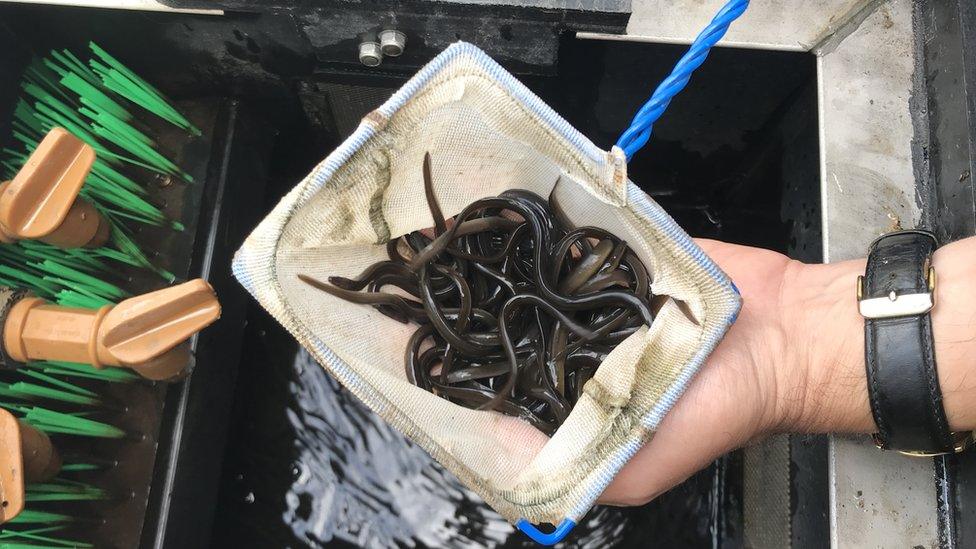Norwich's eel counter says they could 'disappear in our lifetime'
- Published

Technical specialist Jez Wood counting eels at New Mills Yard pumping station in Norwich
Eels are so endangered they could become extinct in our lifetime, an Environment Agency expert warned.
Jez Wood monitors numbers of migrating eels in Norfolk, Suffolk and Essex and said the fish are finding it harder to negotiate waterways.
The agency said global eel numbers were down 95% in the last 40 years and are not improving as hoped.
Mr Wood says climate change, overfishing and river barriers hinder "these astonishing creatures".
Eels start their lives in the Sargasso Sea near the Caribbean and the European eel species travels across the Atlantic to freshwater habitats.
Mr Wood counts the number of eels on the River Wensum in Norwich. The count takes place at an "eel escalator" - a structure which helps them negotiate a river barrier at the New Mills Yard pumping station.

The "eel escalator" at New Mills Yard helps the fish climb over the river barrier as they head upstream on the Wensum

The European eel begins life in the Sargasso Sea as larvae and numbers have been dropping since the 18th and 19th Centuries
The eels use the pass between April and September.
Despite annual numbers rising to 34,000 when the pass was upgraded in 2016, that figure fell to 3,606 in 2017, but then rose to about 8,000 last year.
No eels were counted in April and May this year - but counts in July (usually the busiest month) and August have boosted the total to 2,162 so far in 2019.

European eels are counted as they make their way upstream on the River Wensum
"You have to credit the water companies - everybody's working together to protect eels, but they're also a key species - a lot of animals survive on eating eels, like bitterns, herons, otters," said Mr Wood.
"It's not an exaggeration to say they could disappear in our lifetime."
He said statistics for individual rivers were only an indicator of the overall population of eels as a wide range of variables came into play each year, such as differing water temperatures and pressures and a lack of understanding about why eels tend to favour different rivers in different years.
David Bunt, director of conservation operations at the Sustainable Eel Group, said European eel numbers have declined since the Industrial Revolution and the creation of more dams, sluices, weirs and hydropower.
Eels are faced with more than 1.3 million impassable river barriers across Europe, he said.
"They are an integral part of the freshwater ecology - and they are superb recyclers of nutrients - as well as of high commercial and economic value," he added.


Eel migration routes to the Sargasso Sea
The extraordinary life cycle of eels
Eels begin life in one place - the Sargasso Sea in the north Atlantic, near the Caribbean island of Bermuda
They spend 18 months swimming 3,000 miles (4,800km) across the Atlantic Ocean, floating on currents and propelled by the Gulf Stream to find freshwater homes
They can live for five to 20 years feeding and growing in the freshwater rivers and lakes of Europe
Every autumn, eels make the return journey as "silver eels" to the Sargasso, to spawn for a single time - and die
- Published16 June 2019

- Published17 May 2019

- Published22 November 2018

- Published9 August 2017

- Published5 October 2016

- Published19 October 2013
